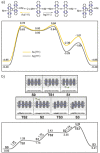Surface-Assisted Synthesis of N-Containing π-Conjugated Polymers
- PMID: 35604199
- PMCID: PMC9259725
- DOI: 10.1002/advs.202200407
Surface-Assisted Synthesis of N-Containing π-Conjugated Polymers
Abstract
On-surface synthesis has recently emerged as a powerful strategy to design conjugated polymers previously precluded in conventional solution chemistry. Here, an N-containing pentacene-based precursor (tetraazapentacene) is ex-professo synthesized endowed with terminal dibromomethylene (:CBr2 ) groups to steer homocoupling via dehalogenation on metallic supports. Combined scanning probe microscopy investigations complemented by theoretical calculations reveal how the substrate selection drives different reaction mechanisms. On Ag(111) the dissociation of bromine atoms at room temperature triggers the homocoupling of tetraazapentacene units together with the binding of silver adatoms to the nitrogen atoms of the monomers giving rise to a N-containing conjugated coordination polymer (P1). Subsequently, P1 undergoes ladderization at 200 °C, affording a pyrrolopyrrole-bridged conjugated polymer (P2). On Au(111) the formation of the intermediate polymer P1 is not observed and, instead, after annealing at 100 °C, the conjugated ladder polymer P2 is obtained, revealing the crucial role of metal adatoms on Ag(111) as compared to Au(111). Finally, on Ag(100) the loss of :CBr2 groups affords the formation of tetraazapentacene monomers, which coexist with polymer P1. Our results contribute to introduce protocols for the synthesis of N-containing conjugated polymers, illustrating the selective role of the metallic support in the underlying reaction mechanisms.
Keywords: conjugated polymers; N-heteroacenes; on-surface synthesis; scanning probe microscopies.
© 2022 The Authors. Advanced Science published by Wiley-VCH GmbH.
Conflict of interest statement
The authors declare no conflict of interest.
Figures





References
-
- Pavliček N., Mistry A., Majzik Z., Moll N., Meyer G., Fox D. J., Gross L., Nat. Nanotechnol. 2017, 12, 308. - PubMed
-
- Mishra S., Yao X., Chen Q., Eimre K., Gröning O., Ortiz R., Di Giovannantonio M., Sancho‐García J. C., Fernández‐Rossier J., Pignedoli C. A., Müllen K., Ruffieux P., Narita A., Fasel R., Nat. Chem. 2021, 13, 581. - PubMed
-
- Sánchez‐Grande A., Urgel J. I., Veis L., Edalatmanesh S., Santos J., Lauwaet K., Mutombo P., Gallego J. M., Brabec J., Beran P., Nachtigallová D., Miranda R., Martín N., Jelínek P., Écija D., J. Phys. Chem. Lett. 2021, 12, 330. - PubMed
-
- Lafferentz L., Ample F., Yu H., Hecht S., Joachim C., Grill L., Science 2009, 323, 1193. - PubMed
-
- Cai J., Ruffieux P., Jaafar R., Bieri M., Braun T., Blankenburg S., Muoth M., Seitsonen A. P., Saleh M., Feng X., Müllen K., Fasel R., Nature 2010, 466, 470. - PubMed
Grants and funding
- Y2018/NMT-4783/Comunidad de Madrid
- SEV-2016-0686/"Severo Ochoa" Programme for Centers of Excellence in R&D
- 886314/European Union's Horizon 2020 research and innovation programme under the Marie Skłodowska-Curie
- 2009 00971/Swedish Research Council and the Swedish Government Strategic Research Area in Materials Science on Functional Materials at Linköping University
- PID2019-108532GB-I00/Ministerio de Ciencia, Innovación y Universidades
LinkOut - more resources
Full Text Sources
Research Materials
Miscellaneous
